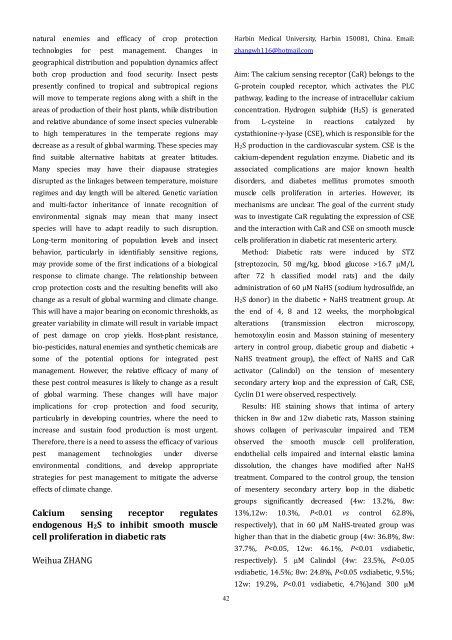Welcome to the 31st IUBS General Assembly and Conference on ...
Welcome to the 31st IUBS General Assembly and Conference on ...
Welcome to the 31st IUBS General Assembly and Conference on ...
Create successful ePaper yourself
Turn your PDF publications into a flip-book with our unique Google optimized e-Paper software.
natural enemies <str<strong>on</strong>g>and</str<strong>on</strong>g> efficacy of crop protecti<strong>on</strong><br />
technologies for pest management. Changes in<br />
geographical distributi<strong>on</strong> <str<strong>on</strong>g>and</str<strong>on</strong>g> populati<strong>on</strong> dynamics affect<br />
both crop producti<strong>on</strong> <str<strong>on</strong>g>and</str<strong>on</strong>g> food security. Insect pests<br />
presently c<strong>on</strong>fined <str<strong>on</strong>g>to</str<strong>on</strong>g> tropical <str<strong>on</strong>g>and</str<strong>on</strong>g> subtropical regi<strong>on</strong>s<br />
will move <str<strong>on</strong>g>to</str<strong>on</strong>g> temperate regi<strong>on</strong>s al<strong>on</strong>g with a shift in <str<strong>on</strong>g>the</str<strong>on</strong>g><br />
areas of producti<strong>on</strong> of <str<strong>on</strong>g>the</str<strong>on</strong>g>ir host plants, while distributi<strong>on</strong><br />
<str<strong>on</strong>g>and</str<strong>on</strong>g> relative abundance of some insect species vulnerable<br />
<str<strong>on</strong>g>to</str<strong>on</strong>g> high temperatures in <str<strong>on</strong>g>the</str<strong>on</strong>g> temperate regi<strong>on</strong>s may<br />
decrease as a result of global warming. These species may<br />
find suitable alternative habitats at greater latitudes.<br />
Many species may have <str<strong>on</strong>g>the</str<strong>on</strong>g>ir diapause strategies<br />
disrupted as <str<strong>on</strong>g>the</str<strong>on</strong>g> linkages between temperature, moisture<br />
regimes <str<strong>on</strong>g>and</str<strong>on</strong>g> day length will be altered. Genetic variati<strong>on</strong><br />
<str<strong>on</strong>g>and</str<strong>on</strong>g> multi‐fac<str<strong>on</strong>g>to</str<strong>on</strong>g>r inheritance of innate recogniti<strong>on</strong> of<br />
envir<strong>on</strong>mental signals may mean that many insect<br />
species will have <str<strong>on</strong>g>to</str<strong>on</strong>g> adapt readily <str<strong>on</strong>g>to</str<strong>on</strong>g> such disrupti<strong>on</strong>.<br />
L<strong>on</strong>g‐term m<strong>on</strong>i<str<strong>on</strong>g>to</str<strong>on</strong>g>ring of populati<strong>on</strong> levels <str<strong>on</strong>g>and</str<strong>on</strong>g> insect<br />
behavior, particularly in identifiably sensitive regi<strong>on</strong>s,<br />
may provide some of <str<strong>on</strong>g>the</str<strong>on</strong>g> first indicati<strong>on</strong>s of a biological<br />
resp<strong>on</strong>se <str<strong>on</strong>g>to</str<strong>on</strong>g> climate change. The relati<strong>on</strong>ship between<br />
crop protecti<strong>on</strong> costs <str<strong>on</strong>g>and</str<strong>on</strong>g> <str<strong>on</strong>g>the</str<strong>on</strong>g> resulting benefits will also<br />
change as a result of global warming <str<strong>on</strong>g>and</str<strong>on</strong>g> climate change.<br />
This will have a major bearing <strong>on</strong> ec<strong>on</strong>omic thresholds, as<br />
greater variability in climate will result in variable impact<br />
of pest damage <strong>on</strong> crop yields. Host‐plant resistance,<br />
bio‐pesticides, natural enemies <str<strong>on</strong>g>and</str<strong>on</strong>g> syn<str<strong>on</strong>g>the</str<strong>on</strong>g>tic chemicals are<br />
some of <str<strong>on</strong>g>the</str<strong>on</strong>g> potential opti<strong>on</strong>s for integrated pest<br />
management. However, <str<strong>on</strong>g>the</str<strong>on</strong>g> relative efficacy of many of<br />
<str<strong>on</strong>g>the</str<strong>on</strong>g>se pest c<strong>on</strong>trol measures is likely <str<strong>on</strong>g>to</str<strong>on</strong>g> change as a result<br />
of global warming. These changes will have major<br />
implicati<strong>on</strong>s for crop protecti<strong>on</strong> <str<strong>on</strong>g>and</str<strong>on</strong>g> food security,<br />
particularly in developing countries, where <str<strong>on</strong>g>the</str<strong>on</strong>g> need <str<strong>on</strong>g>to</str<strong>on</strong>g><br />
increase <str<strong>on</strong>g>and</str<strong>on</strong>g> sustain food producti<strong>on</strong> is most urgent.<br />
Therefore, <str<strong>on</strong>g>the</str<strong>on</strong>g>re is a need <str<strong>on</strong>g>to</str<strong>on</strong>g> assess <str<strong>on</strong>g>the</str<strong>on</strong>g> efficacy of various<br />
pest management technologies under diverse<br />
envir<strong>on</strong>mental c<strong>on</strong>diti<strong>on</strong>s, <str<strong>on</strong>g>and</str<strong>on</strong>g> develop appropriate<br />
strategies for pest management <str<strong>on</strong>g>to</str<strong>on</strong>g> mitigate <str<strong>on</strong>g>the</str<strong>on</strong>g> adverse<br />
effects of climate change.<br />
Calcium sensing recep<str<strong>on</strong>g>to</str<strong>on</strong>g>r regulates<br />
endogenous H 2 S <str<strong>on</strong>g>to</str<strong>on</strong>g> inhibit smooth muscle<br />
cell proliferati<strong>on</strong> in diabetic rats<br />
Weihua ZHANG<br />
Harbin Medical University, Harbin 150081, China. Email:<br />
zhangwh116@hotmail.com<br />
Aim: The calcium sensing recep<str<strong>on</strong>g>to</str<strong>on</strong>g>r (CaR) bel<strong>on</strong>gs <str<strong>on</strong>g>to</str<strong>on</strong>g> <str<strong>on</strong>g>the</str<strong>on</strong>g><br />
G‐protein coupled recep<str<strong>on</strong>g>to</str<strong>on</strong>g>r, which activates <str<strong>on</strong>g>the</str<strong>on</strong>g> PLC<br />
pathway, leading <str<strong>on</strong>g>to</str<strong>on</strong>g> <str<strong>on</strong>g>the</str<strong>on</strong>g> increase of intracellular calcium<br />
c<strong>on</strong>centrati<strong>on</strong>. Hydrogen sulphide (H 2 S) is generated<br />
from L‐cysteine in reacti<strong>on</strong>s catalyzed by<br />
cystathi<strong>on</strong>ine‐γ‐lyase (CSE), which is resp<strong>on</strong>sible for <str<strong>on</strong>g>the</str<strong>on</strong>g><br />
H 2 S producti<strong>on</strong> in <str<strong>on</strong>g>the</str<strong>on</strong>g> cardiovascular system. CSE is <str<strong>on</strong>g>the</str<strong>on</strong>g><br />
calcium‐dependent regulati<strong>on</strong> enzyme. Diabetic <str<strong>on</strong>g>and</str<strong>on</strong>g> its<br />
associated complicati<strong>on</strong>s are major known health<br />
disorders, <str<strong>on</strong>g>and</str<strong>on</strong>g> diabetes mellitus promotes smooth<br />
muscle cells proliferati<strong>on</strong> in arteries. However, its<br />
mechanisms are unclear. The goal of <str<strong>on</strong>g>the</str<strong>on</strong>g> current study<br />
was <str<strong>on</strong>g>to</str<strong>on</strong>g> investigate CaR regulating <str<strong>on</strong>g>the</str<strong>on</strong>g> expressi<strong>on</strong> of CSE<br />
<str<strong>on</strong>g>and</str<strong>on</strong>g> <str<strong>on</strong>g>the</str<strong>on</strong>g> interacti<strong>on</strong> with CaR <str<strong>on</strong>g>and</str<strong>on</strong>g> CSE <strong>on</strong> smooth muscle<br />
cells proliferati<strong>on</strong> in diabetic rat mesenteric artery.<br />
Method: Diabetic rats were induced by STZ<br />
(strep<str<strong>on</strong>g>to</str<strong>on</strong>g>zocin, 50 mg/kg, blood glucose >16.7 µM/L<br />
after 72 h classified model rats) <str<strong>on</strong>g>and</str<strong>on</strong>g> <str<strong>on</strong>g>the</str<strong>on</strong>g> daily<br />
administrati<strong>on</strong> of 60 µM NaHS (sodium hydrosulfide, an<br />
H 2 S d<strong>on</strong>or) in <str<strong>on</strong>g>the</str<strong>on</strong>g> diabetic + NaHS treatment group. At<br />
<str<strong>on</strong>g>the</str<strong>on</strong>g> end of 4, 8 <str<strong>on</strong>g>and</str<strong>on</strong>g> 12 weeks, <str<strong>on</strong>g>the</str<strong>on</strong>g> morphological<br />
alterati<strong>on</strong>s (transmissi<strong>on</strong> electr<strong>on</strong> microscopy,<br />
hemo<str<strong>on</strong>g>to</str<strong>on</strong>g>xylin eosin <str<strong>on</strong>g>and</str<strong>on</strong>g> Mass<strong>on</strong> staining of mesentery<br />
artery in c<strong>on</strong>trol group, diabetic group <str<strong>on</strong>g>and</str<strong>on</strong>g> diabetic +<br />
NaHS treatment group), <str<strong>on</strong>g>the</str<strong>on</strong>g> effect of NaHS <str<strong>on</strong>g>and</str<strong>on</strong>g> CaR<br />
activa<str<strong>on</strong>g>to</str<strong>on</strong>g>r (Calindol) <strong>on</strong> <str<strong>on</strong>g>the</str<strong>on</strong>g> tensi<strong>on</strong> of mesentery<br />
sec<strong>on</strong>dary artery loop <str<strong>on</strong>g>and</str<strong>on</strong>g> <str<strong>on</strong>g>the</str<strong>on</strong>g> expressi<strong>on</strong> of CaR, CSE,<br />
Cyclin D1 were observed, respectively.<br />
Results: HE staining shows that intima of artery<br />
thicken in 8w <str<strong>on</strong>g>and</str<strong>on</strong>g> 12w diabetic rats, Mass<strong>on</strong> staining<br />
shows collagen of perivascular impaired <str<strong>on</strong>g>and</str<strong>on</strong>g> TEM<br />
observed <str<strong>on</strong>g>the</str<strong>on</strong>g> smooth muscle cell proliferati<strong>on</strong>,<br />
endo<str<strong>on</strong>g>the</str<strong>on</strong>g>lial cells impaired <str<strong>on</strong>g>and</str<strong>on</strong>g> internal elastic lamina<br />
dissoluti<strong>on</strong>, <str<strong>on</strong>g>the</str<strong>on</strong>g> changes have modified after NaHS<br />
treatment. Compared <str<strong>on</strong>g>to</str<strong>on</strong>g> <str<strong>on</strong>g>the</str<strong>on</strong>g> c<strong>on</strong>trol group, <str<strong>on</strong>g>the</str<strong>on</strong>g> tensi<strong>on</strong><br />
of mesentery sec<strong>on</strong>dary artery loop in <str<strong>on</strong>g>the</str<strong>on</strong>g> diabetic<br />
groups significantly decreased (4w: 13.2%, 8w:<br />
13%,12w: 10.3%, P
















